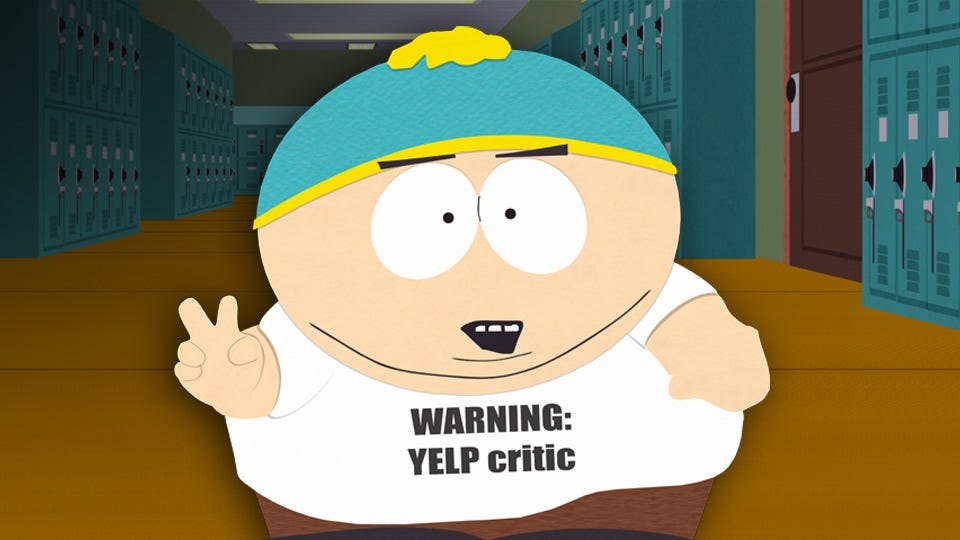The Taxonomy of Today's Restaurant "Critics"
7 food tastemaker archetypes
Throughout November, we’ll be posting reported features, essays, lists, and more around our monthly theme: The Influence Appetite.
I don't know if you've read our 42 Secret Puppet Masters of Food but you should. It's a scientific and rigorously researched look at the shadowy food Illuminati secretly influencing where you dine and what you order when you get there.
The term 'restaurant critic' has exploded this century to include more than just old-school print scribblers — there's a broader coalition of trendsetters on and offline vying for the attention of the ‘hungry, multiple tribes of connoisseurs who are in-the-know. From traditional influencers to viral TikTokers, whose food opinions matter most? The pros or the dilettantes? I have gone to the immense effort of quickly and sloppily ranking the different kinds of voices out there telling us what and where to eat.
7. The Longform Yelp Reviewer
The internet is a collection of bottomless pits, and one of my favorite abysses is Yelp, in which dwells the longform Yelp reviewer. Now, most people post little write-ups about restaurants they've eaten at — this truck has great tacos, but the service was lousy at this other cafe. But the Longform Yelp Reviewer’s posts resemble epic poems; they almost verge on folk art, 1,000-word long rants, or rapturous raves powered by a mix of inspiration and madness. Does anyone pay attention to Yelp anymore? Nobody’s told these self-identifying scribes.
6. The Fancy Food Influencer
Did you know another word for 'influencer' is 'publicist?' True story. Social media is still clogged with dozens of food influencers who take the most incredible photos of expensive donuts and ramen and have nothing but AMAZING things to say about where they're eating dinner, which they were probably paid to say in the first place or else getting banned for the unpalatability of their presence. When these influencers aren’t annoying the table next to them with their constant Instagramming, they’re at home, staring dead-eyed into their ring light, talking about food, food, food, frying their voices and the frontal lobes of anyone watching.
5. Your Friend, “The Foodie”
A true foodie calls themselves a foodie without ever realizing how corny it is to refer to yourself as a foodie. What they lack in self-awareness, they make up for in la passion for cuisine. Your foodie friend does the work, so you don't have to: they know what's happening and are the first to try all the fabulous— and expensive—hot spots. They're like guinea pigs. And then they pass on to you their hard-won opinions.
4. The Big-Time Restaurant Critic Demi-God
In every major city, there's a celebrated newspaper that employs an eloquent and/or erudite food critic who is feared. In some towns, there’s more than one. These wordsmiths are gourmets who know the difference between caviar and roe. They're also demi-gods who sometimes delight in dropping scathing little thunderbolts on restaurants that displeased them. Not all newspaper critics are like that. The New York Times' Pete Wells is a cool call-it-like-he-sees-it dude. But let’s focus on the meanies. Yes, I am weak and drawn to vulgar displays of wit and unnecessary meanness.
3. The Almost-Extinct Magazine Bon Vivant
The magazine critic is a wild card. Some are clearly on the take and write lovely press releases disguised as reviews or stories , and then there are critics like The New Yorker's Helen Rosner, who folds wit, research, and an impeccable palette into everything she writes. I miss magazines. I miss living in a lazier, less noisy time, too. I enjoy flipping pages so much more than scrolling. The lead time on monthly magazines means writers can sometimes have more time eating, writing, and sitting with their thoughts. I can do without the hacks but I wouldn't mind a few more writers of Rosner’s integrity in the game.
2. The Chill Food Writer Who Should Be Writing For An Alt-Weekly
I also miss "alternative" newspapers (a few websites, like Hell Gate in NYC, are trying to carry on the tradition.) Alt-weeklies were scrappier, funnier, and wittier than their siblings, big-time newspapers. They generally covered a city's underbelly and were where the coolest writers explored hidden neighborhoods. These rags almost always had a food writer with a knack for finding the best empanadas or pho, a real eccentric street journo with an appetite for writing about ambitious young chefs and holes-in-the-wall serving cheap, delicious eats. Think the late-great Pulitzer Prize-winning Jonathan Gold or The Washington Post’s Tim Carman.
1. The Car Critic
The internet is also a magical place where true blue enthusiasts can find an audience. This is a golden age of citizen critics, whether you're a down-to-earth restaurant with millions of followers like Keith Lee on TikTok or just someone who reviews food from their car — who didn’t love seeing earnest young fellow @lukefoods get his mind blown by Indian food? I expect very little from a critic who reviews food in their car, but I'm always delighted by their videos about cheeseburgers, BBQ, and baos. When it comes to being influenced, nothing beats some person with an iPhone who has to tell the world about the fried chicken shack they found.











